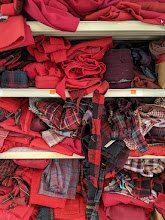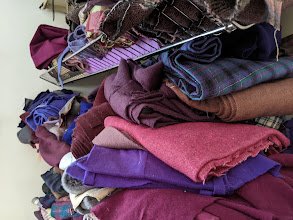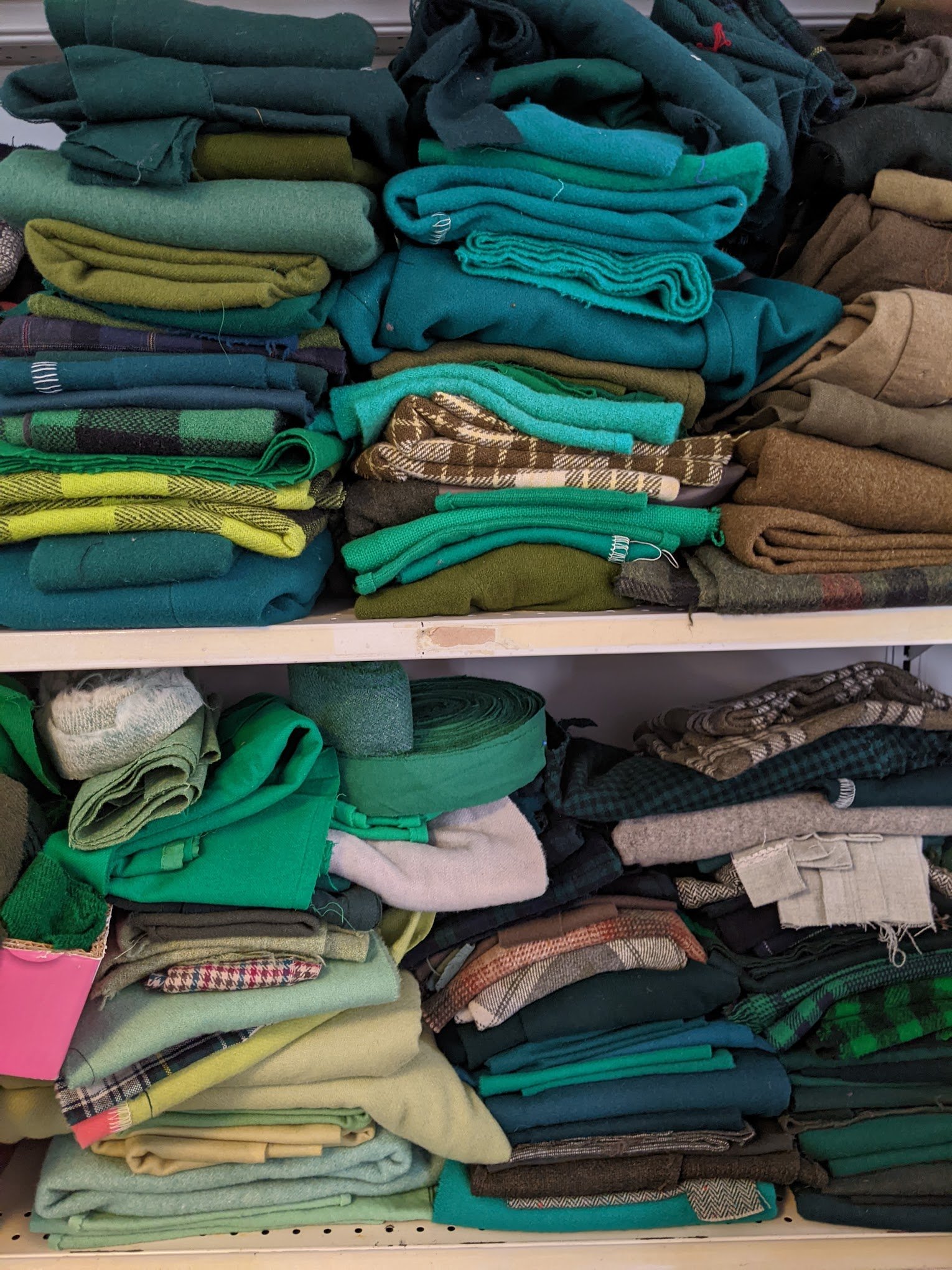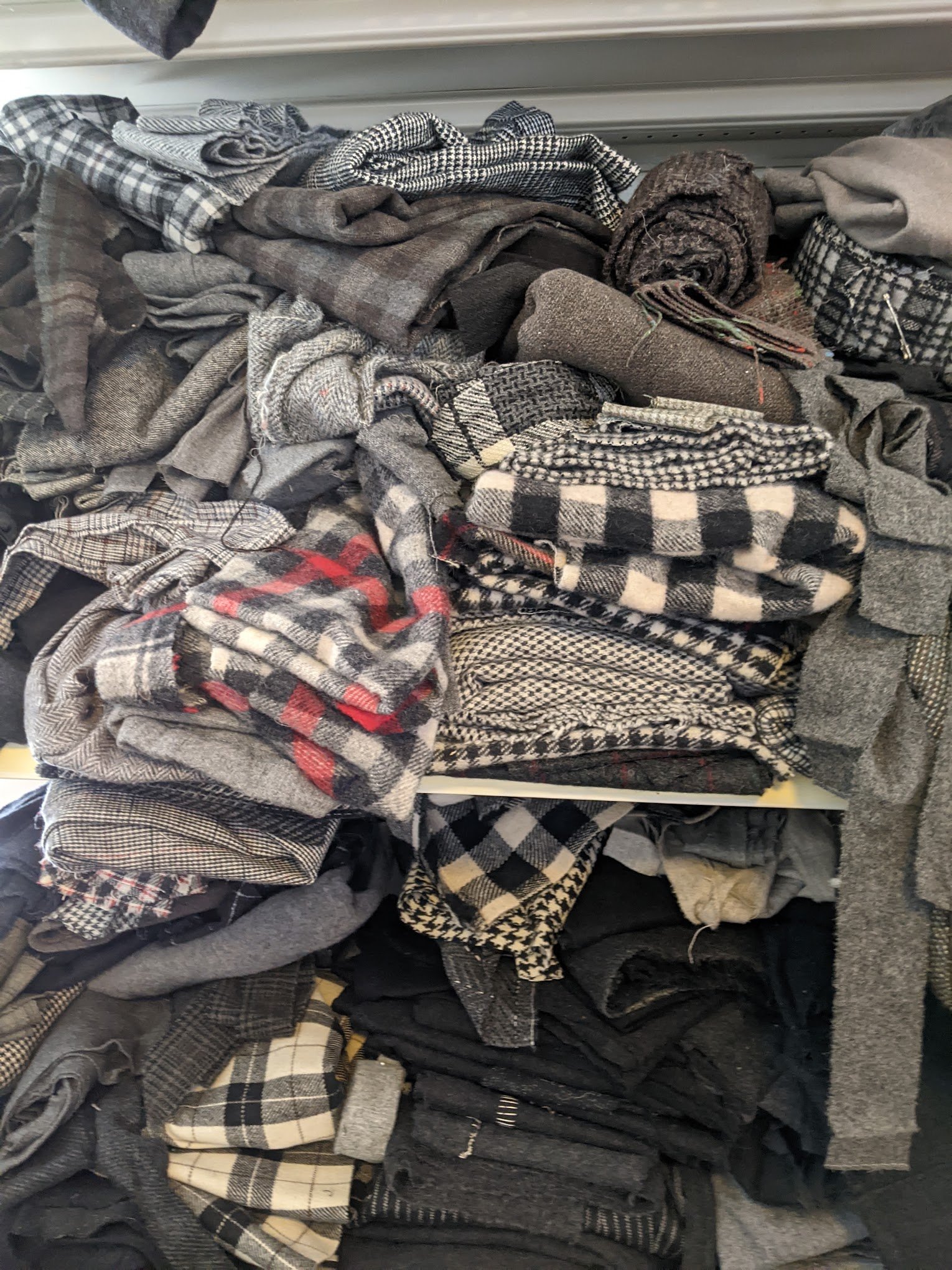BRAIDING a new waltz feat. Helen Condon: "SUNSET ON THE RAQUETTE"
CLICK HERE TO WATCH MUSIC VIDEO.
CONCERT ANNOUNCEMENT!
OCTOBER 22, Pickens Hall, Heuvelton, NY
TAUNY [Traditional Arts in Upstate New York] presents Gretchen Koehler's "Fiddling With Traditions" - a new fiddle suite of handcrafted tunes inspired by North Country artists- at the historic Pickens Hall, Heuvelton, NY on October 22, 7PM. The concert will feature fiddler Gretchen Koehler & pianist Daniel Kelly. "Fiddling with Traditions" is made possible by the New York State Council on the Arts with the support of the Office of the Governor and the New York State Legislature.
Gretchen Koehler’s fiddle and Helen Condon’s rug. (Koehler photo.)
“Marcy Sunset” from Helen Condon’s Adirondack Series. Courtesy of Jill Breit. (Koehler photo.)
Fiddler Gretchen Koehler and rug braider Helen Condon at the Adirondack Rug Braiding studio, Parishville, NY. (Koehler photo.)
FIDDLING WITH TRADITIONS
Early in 2022 I began a project called “Fiddling with Traditions,” setting out to compose a new collection of tunes inspired by conversations with Northern New York artists. After a creative lull during the pandemic, I was in search of new ways to think about approaching music. With the support of TAUNY [Traditional Arts in Upstate New York] , I conducted interviews with artists from a variety of media from papermaking to blacksmithing. Over the course of this year, I have composed a new suite of tunes, as well as written articles and am currently producing a series of music videos featuring these extraordinary folks. A musical celebration/concert is scheduled for October 22 in Northern New York.
~Gretchen
ADIRONDACK RUG BRAIDING, Parrishville, New York
I spent a lovely afternoon meeting rug braider Helen Condon at her historic home and studio, Adirondack Rug Braiding, in Parishville, NY. From the moment I stepped through the door, I was treated to Helen’s vibrant energy and love for the history tied to this very special place.
Hand braided baskets by Helen Condon, Adirondack Rug Braiding. (Koehler photo.)
PARISHVILLE GRANGE HALL
Built in 1863, this former boarding house was used to host workers from the 14 factories located in Parishville. In 1920, the Parishville Grange bought the building and turned 6 of the upstairs bedrooms into a square dance hall and meeting space. It remained so for 40 years until Helen purchased the house and converted the upper level into her studio space.
Everything in her wonderful home, from floor to ceiling, was full of rich history, memories and great stories. I especially lit up as Helen told me more about the history of the old square dance hall. The thought of horse drawn wagons coming to town to hear the fiddler play for a square dance gave me a deep connection to this space. This old dance hall was going to get a new “Old Time” dance tune.
“The Grange,” now the site of Adirondack Rug Braiding in Parishville, NY (Used with permission.)
“The thought of horse drawn wagons and sleighs coming to town to hear the fiddler play for a square dance gave me a deep connection to this space. This old dance hall was going to get a new “Old Time” dance tune.”
Fiddler Gretchen Koehler sitting on the rug her mother braided 45 years ago.
KOEHLER RUGS
I had a personal interest in rug braiding. The floors of my childhood home in Massachusetts were covered with several grand rugs braided by my mother, Shirley Koehler. First learning from a class, it became a hobby she enjoyed for many years. I love the 45 year old rugs that now lay on the hardwood floors of my home in the North Country of Northern New York. Growing up, my sons were not easy on our house (to put it mildly!) Braided rugs are made to last.
MAKING A RUG
Rug braiding is not a fast process. It can take many weeks, even months, and in my mom’s case, years to complete a large rug. For those unfamiliar, you need material, in Helen’s case wool, that is ripped into long strips. When I watch her in action, it is obvious she really enjoys this part of the process. She said she finds the sound very comforting. I told her I remembered helping my mom rip many yards out back at our picnic table. Helen explained that if the fabric is mostly wool, it will rip easily along the grain.
Once she has a pile of strips, she connects the ends with her sewing machine and is ready to braid. She assembles the rug by lacing the rows together with twine. Helen makes rugs of various sizes, hand braided baskets, and door knob wreaths. I asked what a rug braider from the past would think about her technique. Other than a small variation in how she connects the braids, there is virtually no difference from the way it was done many years ago.
Rug braider Helen Condon ripping wool into strips to prepare for braiding. (Koehler photos.)
Helen Condon rug. (Koehler photo.)
Sarah Campbell Taylor taught her granddaughter Helen Condon how to braid rugs. (Used with permission.)
LEARNING TO BRAID
Historically, people used worn out, discarded clothing or even left over plastic “Wonder Bread” packages for their strips. Helen’s grandmother, Sarah Campbell Taylor who taught her, said “use all the fabric you need, except for the elbows and the knees.” Helen smiled as she could see I didn’t fully understand what that meant. She explained that the elbows and knees were the most worn out part and often had patches that were not ideal for braiding.
The musician in me recognized the importance of the number three in her folk art and I decided that a waltz with three beats per measure would be in order. Now that I had a dance type (waltz) and fiddle genre to work with (Old Time), I listened for things that were important in her tradition to include in the arrangement. Helen says that as she braids strips of old clothing together, she “reuses, recycles and remembers.” Beautiful sentiment! I wanted to honor this thought with a nostalgic moment of three part fiddle harmony.
“The musician in me recognized the importance of the number three in her folk art. I decided that a waltz with three beats per measure would be in order.”
DANCE HALL
When I first entered her big workroom (the former square dance hall), I could almost hear echoes of tunes I still play today. St. Anne’s Reel, Irish Washerwoman, Fisher’s Hornpipe and The Black Velvet Waltz. After my time with Helen, I reached out to my good friend, fiddler Don Woodcock of Rensselaer Falls, NY. He confirmed my suspicion that his father, fiddler Howard Woodcock had played in this very site! Don told me that he played with the Stiles family who lived not far from the Woodcock family. The mother, Daisy Stiles, played piano and her two daughters played trumpet and clarinet. Her son played drums and Mahlon Spring from the Parishville/Colton area “called” the dances. Don told me that Mahlon’s granddaughter can can still recall these dances from her youth.
Fiddler Howard Woodcock c. 1975 (Used with permission.)
“Helen says that as she braids strips of old clothing together she “reuses, recycles and remembers.” Beautiful sentiment! I wanted to honor this with a nostalgic moment of three part fiddle harmony.”
The Adirondack Rug Braiding Studio, Parrishville, NY (Koehler photo.)
SUPPLIES
Along the walls were shelves from floor to ceiling bursting with bolts of fabric and old wool clothing. The plaids, tweeds and plain wool were organized by color. Around the room were rugs in various stages of repair and large baskets on the floor filled with long 3” strips ready for braiding. A section of wall was dedicated to what looked like miles of twine. It reminded me of the wall of a violin shop with horses' tails waiting for the luthier to rehair violin bows. She said she acquired the twine from the old slipper factory in Malone, NY and I shared that my husband’s grandparents worked the nearby slipper factory in Bombay, NY in the 1920s.
Helen Condon braiding. (Koehler photo.)
TENSION & RELEASE
In rug braiding, you not only keep the tension of the braid tight by using thumb strength, you pull the braid towards your body using arm strength. The braid is clamped to a steady surface, and every few feet you are treated to a moment of release as you move and reclamp the braid to start the process again.
As the braids grow longer, you are ready to lace the rows side-by-side with strong twine. Since it is essential that the rug lay flat and not curl or become wavy, Helen makes sure every row is 7 inches longer than its predecessor and adjusts the tension of her lacing as she works.
My partner, pianist Daniel Kelly, and I talked about how we could represent the tension and relaxation in terms of sound. The long braid could be represented by the fiddle holding one long note. The lacing could be represented with a sequence of piano chords creating a mild musical conflict and resolution.
With her rug pattern in the background, Helen Condon begins to lace the braided strands together. (Koehler photo.)
“The long braid could be represented by the fiddle holding one long note. The lacing could be represented through a sequence of chords creating tension and release on the piano.”
“The Three Sisters” from Helen Condon’s Adirondack Rug Series. (Koehler photo.)
VARIATIONS AND IMPROVISING
I was surprised at how much interaction Helen had with the rugs as she worked. I thought, once the size, design, and colors had been settled, that the actual creation of the rug would be rather repetitive. Helen got animated as she talked about working “with” the rug. She calculates how much color will make it around the next curve, re-thinks color combinations , makes adjustments on the fly as she ensures the rug lies flat. She and the rug work together as a team.
I asked her if she lined up 5 of the same rug from her Adirondack Rug Series, would they look exactly the same. To the casual observer, yes they are all the same rug, but as you look closely, you’d see that there are variations in the fabric, color, pattern and there is a lot of subtle improvising. This is exactly what I do as a fiddler! I could play the same tune 5 times, but each time I repeat, I make tiny changes in my bowing, fingering, and ornamentation. In other words, I never play a tune the same way twice. I found an unexpected connection between rug braiding and my approach to fiddling.
“I never play a tune the same way twice. I found an unexpected connection between rug braiding and my approach to fiddling.”
Helen Condon rug. (Koehler photo.)
Taxidermy ducks inspired her “Adirondack Water Fowl” Collection. (Koehler photo)
INSPIRATION & CREATIVE PROCESS
In the studio, next to the “purple” wall, I couldn’t help but notice a collection of taxidermy ducks hanging on the wall. She explained the serendipity of coming into possession of these 5 ducks and that they had inspired her to create a new “Adirondack Water Fowl” collection.
I asked her about her creative process. She is drawn to nature’s color palette and loves to translate it into rugs. It may come from a familiar drive by a field of wildflowers, a hike in the ADK, or in this case, ducks. For these new rugs, she was looking at their feathers, thinking about color order, pattern, balance, beauty and finally the “story” that she would write to accompany the rugs.
STORY
I asked her more about the story. She told me that she writes a descriptive paragraph, full of colorful imagery to accompany all of her rugs. She feels this is an important part of the process. For sixty years she has been encouraging her students to do the same. As her most recent “student,” I was smitten with this idea! Selecting an image and writing a vignette was the spark I needed to begin a tune.
“Sunlight dances on the yellow faces of the tall Common Mullein. The fields are alive with the button heads of the Tansy and the shaggy Goldenrod. The flat blue flower of the Chicory hides its head against the dark green stems. The orange Hawkweed is dwarfed by the rest, but its bright color sings out, “See me!” to the traveler of these Adirondack side roads. This dazzling array of color is hidden away in our minds so that when winter comes and we see the tall brown heads of the Mullein over the snow we recall the color of ‘August Wildflowers.’”
Fiddler Gretchen Koehler sitting on “A Circle of Quiet” made by Helen Condon, commissioned by Betsy Kepes & Tom Vandewater. (Koehler photo.)
To Helen, thank you so much for spending time with me and sharing your love of history! Your energy is invigorating! I am delighted you were a part of “Fiddling With Traditions.”~Gretchen
LISTENING GUIDE (click arrow to listen)
I present an Old Time waltz to honor the dance hall that Helen Condon converted into The Adirondack Rug Braiding studio. As she braids three strands, I too will work with “threes” as I play this waltz with a 3/4 time signature. At times my fiddle holds one steady note as the piano tightens and loosens the chords to mimic Helen’s hands as she makes sure her rug lies flat on the floor. She says braiding “reuses, recycles and remembers” as she combines used clothing and old fabric. I celebrate this with a nostalgic moment of three part fiddle harmony. Lasty, with Helen’s encouragement, I set the scene of my musical rug with a short story that braids together the colors of a lovely evening. I call this waltz Sunset on the Raquette. Here is my story…
A mom-son fishing trip that ended with a sunset that inspired an old time waltz. (Koehler photo)
“He said, “Wanna go fishing?” She answered with a smile. His strong arms carried his grandfather’s olive green canoe across the field. He slid it into the river, this time avoiding the patch of wild purple iris by the shore, his mom’s favorite. As they waited for the fish to bite, the clouds seemed to be waltzing in skirts of dark purples and pinks around an old dance hall. They paddled as the sky of that perfect summer day slowly faded away into pale blue with a last whisper of yellow. Though her son’s net remained empty, her heart was full - knowing that this precious time together was as fleeting as the light of day. They glided back to shore, got out of the canoe and he couldn’t help but lean into mom, disappointed. She knocked off his baseball cap, kissed his brown hair and said, “Wanna go fishing tomorrow?” He looked up at her with a smile as the sun gently set on the Raquette.”
Here’s a link to the music video! Click the arrow and enjoy!
Fiddler Gretchen Koehler filming “Sunset on the Raquette” music video. (Koehler photo.)























